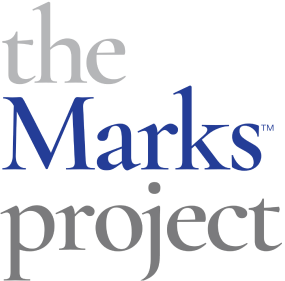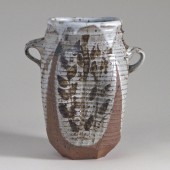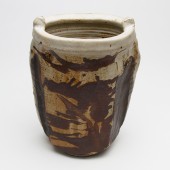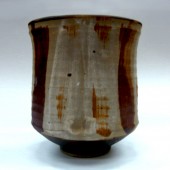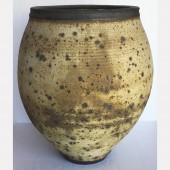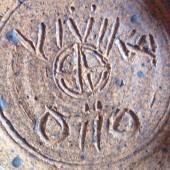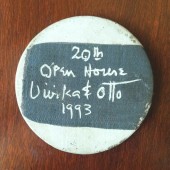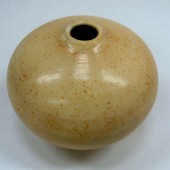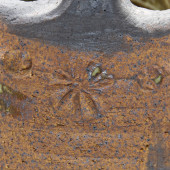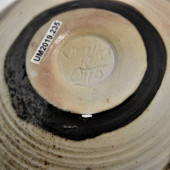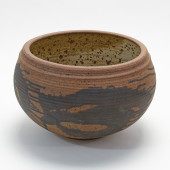![]() Printer version
Printer version
Otto Heino
1915Born East Hampton, Connecticut
1950Otto and Vivika (née Vivien Place) marry
2009Died Ojai, California
EDUCATION
1949-1951League of New Hampshire Craftsmen, Concord, New Hampshire
1954-1955University of Southern California (USC), Los Angeles, California
1955-1962Chouinard Art Institute, Los Angeles, California
PRIMARY WORK EXPERIENCE
1950-1952Studio Potter, Hopkinton, New Hampshire
1952-1955Studio Potter and Instructor, USC
1955-1963Studio Potter, Hoover Street, Los Angeles, California
1958-1963Special Children’s Course and Summer Session, Chouinard Art Institute
1963-1965Studio Potter, East Providence, Rhode Island
1965-1973Studio Potter, Hopkinton, New Hampshire
1973-2009Studio Potter, The Pottery, Ojai, California
BIOGRAPHY
Together with his wife, Vivika Heino, Otto Heino made traditional, thrown vessel forms decorated with rich surface glazes. For nearly 50 years, the Heino’s worked together in a shared workshop both throwing and glazing their own works and working collaboratively. Independently, Otto threw large bottles, tall vases and planters. He also made tiles for Vivika to decorate.
Otto would, on occasion, make his own works. These are usually slab-built, coiled, sculptural or architectural forms, typically larger in scale than Vivika’s. After Vivika died in 1995, he continued working doing all of the throwing and glazing himself. Most of the Heino’s work is signed with both of their names, “Vivika + Otto.” After 1995, and when working on his own, he signed only “Otto.”
Born in East Hampton, Connecticut, Otto was first introduced to pottery in Europe during his military service in World War II. During one of his furloughs in England, Otto visited the St. Ives studio of potter Bernard Leach. It was this visit that first inspired Otto to consider working in pottery; “… when I saw Leach's pottery where people were throwing, they had to master that clay or else the clay would take over. So I decided when I got back to the United States I would take up pottery. I took up pottery with the G.I. and Vivika was teaching.” (Oral history interview with Otto and Vivika Heino, 1981 Mar. 4, Archives of American Art, Smithsonian Institution)
When Otto returned to the US in 1949, he enrolled in pottery classes, paid by the G.I. Bill, at the League of New Hampshire Craftsmen. It was there he met his future wife and partner, Vivika. Vivika had already established herself as a working studio potter and was the Assistant Director of the League. In 1950, the two were married.
In 1952 Vivika was invited to teach at the University of Southern California (USC). The couple stayed on in California for over a decade. It was at USC that Otto learned to throw pottery. Prior to this, he became especially adept at making large, coiled pots. Both Otto and Vivika taught first at the University of Southern California and, then, at Chouinard Art Institute.
In 1963, the couple decided to return to their old studio in Hopkinton, New Hampshire. After nearly another decade on the East Coast, they were invited to purchase the studio of their friend and fellow potter, Beatrice Wood. The Heino’s returned to Ojai, California establishing their gallery, The Pottery, in 1973.
After Vivika’s death in 1995, Otto continued her experiments to develop a lost rich, buttery, yellow glaze formula from the Chin dynasty. He discovered the formula after her death and dedicated the glaze to her.
The Heinos fired in updraft dual fueled kilns. Gas fired kilns were used for bisque firing. The bisque ware was then glaze fired in kilns that were started with gas. When the wood and salt catenary kilns (80 cu. Ft.) were used, they were started with gas, then finished with gas plus salt, or, finished with wood plus salt. For the wood firing, the kiln (90 cu. Ft.) was started with gas and finished with wood. The Denver car kiln was for bisque or glaze, and fired with gas (80 cu. ft.). Two smaller gas kilns were used, one was for bisque firing and for special effects (8 cu. ft.), and the other for bisque or glaze (30 cu. ft.). There were two other kilns, one of 100 cu. feet, and a small wood kiln of 27 cu. feet. (Information courtesy of Ms. Roberta Griffith, December 14, 2014)
Together, Otto and Vivika participated in over 200 national and international exhibits, and were awarded many distinctions and recognitions. In 1978 Otto was awarded the prestigious Gold Medal at the 6th Biennial Invitational Ceramic Fair in Vallauris, France.
An interview with Otto and Vivika Heino conducted March 4, 1981, by Elaine Levin for the Archives of American Art's Oral History Program is available at: http://www.aaa.si.edu/collections/interviews/oral-history-interview-otto-and-vivika-heino-13053.
PUBLIC COLLECTIONS
American Museum of Ceramic Art, Pomona, California
Ariana Museum, Geneva, Switzerland
Arizona State University Art Museum, Tempe, Arizona
Baltimore Museum of Art, Baltimore, Maryland
Brunnier Art Museum, Iowa State University, Ames Iowa
Cooper-Hewitt National Design Museum, Smithsonian Institution, New York, New York
Craft and Folk Art Museum, Los Angeles, California
Des Moines Art Center, Des Moines, Iowa
Everson Museum of Art, Syracuse, New York
Fitchburg Art Museum, Fitchburg, Massachusetts
Fred Jones, Jr. Museum of Art, The University of Oklahoma, Norman, Oklahoma
Hartford Jewish Community Center, Hartford, Connecticut
Joslyn Art Museum, Omaha, Nebraska
Long Beach Museum of Art, Long Beach, California
Los Angeles County Museum of Art (LACMA), Los Angeles, California
Memphis College of Art, Memphis, Tennessee
Mills College Art Museum, Oakland, California
Museum of Art and Design, New York, New York
Newark Museum, Newark, New Jersey
Nora Eccles Harrison Museum of Art, Utah State University, Logan, Utah
St. Paul Gallery, St. Paul, Minnesota
Ruth Chandler Williamson Gallery, Scripps College, Claremont, California
Southern Highland Craft Guild, Asheville, North Carolina
Tweed Museum of Art, University of Minnesota, Duluth, Duluth, Minnesota
University of Illinois at Urbana-Champaign, Champaign, Illinois
BIBLIOGRAPHY
Carney, Margaret, Val Cushing, and Gerry Williams. What You Give Away You Keep Forever: The Vivika and Otto Heino Retrospective.Alfred, NY: Schein-Joseph Museum of Ceramic Art at Alfred University, 1995.
Levin, Elaine. "Otto and Vivika Heino,” Ceramics Monthly, October 1977.
Merrill, Forrest, Vivika Heino, and Otto Heino. The Art of Vivika and Otto Heino. Ventura, CA: Ventura County Museum of History & Art, 2005.
Wallace, Kevin V. and Tim Schiffer. The Art of Vivika & Otto Heino. Ventura, CA: Ventura County Museum of History & Art, 1995.
CV or RESUME: Click Here to Download
Source: College Archives, New York State College of Ceramics
 | Center For Craft |
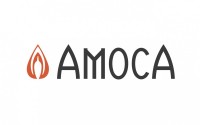 | AMOCA American Museum of Ceramic Art |
The mark with a C in an abstract vase form was used by the Heinos while they were at the Couinard Art institute in the 1950s and 1960s.
Citation: "The Marks Project." Last modified February 8, 2024. http://www.themarksproject.org:443/marks/heino-0
